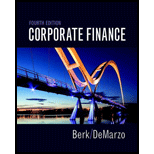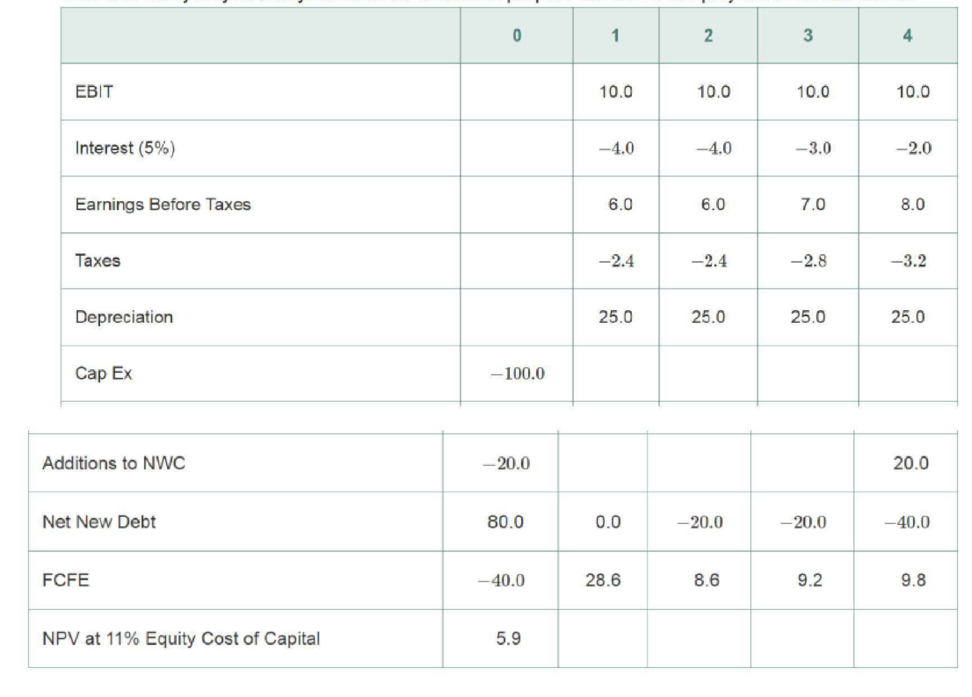
Concept explainers
You are on your way to an important budget meeting. In the elevator, you review the project valuation analysis you had your summer associate prepare for one of the projects to be discussed:

Looking over the spreadsheet, you realize that while all of the cash flow estimates are correct, your associate used the flow-to-equity valuation method and discounted the cash flows using the company’s equity cost of capital of 11%. While the project's risk is similar to the firm’s, the project’s incremental leverage is very different from the company's historical debt-equity ratio of 0.20: For this project, the company will instead borrow $80 million upfront and repay $20 million in year 2, $20 million in year 3, and $40 million in year 4. Thus, the project's equity cost of capital is likely to be higher than the firm’s, not constant over time-invalidating your associate’s calculation.
Clearly, the FTE approach is not the best way to analyze this project. Fortunately, you have your calculator with you, and with any luck you can use a better method before the meeting starts.
- a. What is the present value of the interest tax shield associated with this project?
- b. What are the
free cash flows of the project? - c. What is the best estimate of the project’s value from the information given?
Want to see the full answer?
Check out a sample textbook solution
Chapter 18 Solutions
Corporate Finance (4th Edition) (Pearson Series in Finance) - Standalone book
- For this assignment, you will apply what you have learned from the unit lesson and required unit resources. The Waterways (WP27) case is located on page 27-35 of the textbook. Waterways puts much emphasis on cash flow when it plans for capital investments. The company chose its discount rate of 8% based on the rate of return that it must pay its owners and creditors. Using that rate, Waterways then uses different methods to determine the best decisions for making capital outlays. This year, Waterways is considering buying five new backhoes to replace the backhoes it now has. The new backhoes are faster, cost less to run, provide for more accurate trench digging, have comfort features for the operators, and have 1-year maintenance agreements to go with them. The old backhoes are working just fine, but they do require considerable maintenance. The backhoe operators are very familiar with the old backhoes and would need to learn some new skills to use the new backhoes. The following…arrow_forwardAs a recent graduate of the UWIOC, The General Manager of the company has hired you to work alongside the Financial Controller of the company to help determine whether the company should invest in the new product line. He has provided you with the following questions to guide you in your assessment of the project and to present your findings to the Company. 1. Determine the weighted average cost of capital (WACC) for Vigour Pharmaceuticals. (Formula to be used is attached)arrow_forwardAs a financial analyst, you are tasked with evaluating a capital-budgeting project. You were instructed to use the IRR method, and you need to determine an appropriate hurdle rate. The risk-free rate is 4%, and the expected market rate of return is 11%. Your company has a beta of 0.75, and the project that you are evaluating is considered to have risk equal to the average project that the company has accepted in the past. According to CAPM, the appropriate hurdle rate would be A. 15%. B. 9.25%. C. 4%. D. 11%. E. 0.75%arrow_forward
- A company manager asked you to evaluate an investment opportunity. Select and explain two (2) investment criteria you will use to make a decision as to whether to accept or reject the opportunity. You are the CFO of Midas Mining Ltd and the company is looking to expand its mining operations. Your staff have narrowed it down to two (2) projects, with the cash flows presented in the table below. However, given the substantial cash outlay, your company can only choose one of the projects (A or B). Information Project A Project B Cost $5 550 000 $6 640 000 Required: a) Perform a project evaluation, using the Net Present Value (NPV) The prevailing discount rate is 12%. b) Identify which project (if any) should be accepted by Midas Mining Ltd.arrow_forwardA company puts together a set of cash flow projections and calculates an IRR of 25% for the project. The firm's cost of capital is about 10%. The CEO maintains that the favorability of the calculated IRR relative to the cost of capital makes the project an easy choice for acceptance and urges management to move forward immediately. i. Should this project be evaluated using different standards? ii. How does the possibility of bankruptcy as a result of the project affect the analysis? iii. Are capital budgeting rules still appropriate?arrow_forwardHere, we want to work through a proforma income statement to determine the cash flows from the project. Below are some estimates that the marketing department has determined. Other assumptions necessary for completing the proforma income statement can be found by looking at some of the historical average values in Johnson & Johnson’s financial statements. Suppose Johnson & Johnson (ticker symbol - jnj) has decided to introduce a new heart stent, the Heart Flow. Before they launched the Heart Flow, they analyzed it to see if it would be a desirable investment. The company estimated that it would sell 950,000 Heart Flow’s per year at a price of $75,000 for the next six years. After the first year of sales, the quantity sold will increase by 2% per year for the remaining life of the project.The initial capital outlay is determined to be $15 billion and a $2.0 billion outlay in net working capital (NWC) would also be required. Assume that there is a one-time investment in…arrow_forward
- This homework submission should include all calculations for part (a), completed on the designated tab of the Homework Student Workbook, and a document explaining the implications of your findings for the business or business transaction. After reading this week’s resources, respond to the following:You are a financial analyst for the Brittle Company. The director of capital budgeting has asked you to analyze two proposed capital investments: Projects X and Y. Each project has a cost of $10,000, and the cost of capital for each is 12%. The projects' expected net cash flows are shown in the table below. Expected Net Cash Flows Year Project X Project Y 0 – $10,000 – $10,000 1 6,500 3,500 2 3,000 3,500 3 3,000 3,500 4 1,000 3,500 Use the Workbook to calculate each project's net present value (NPV), internal rate of return (IRR), modified internal rate of return (MIRR), and profitability index (PI). Which project or projects should…arrow_forwardhelps in their capital budgeting decisions. Green Caterpillar Garden Supplies is a small firm, and several of its managers are worried about how soon the firm will be able to recover its initial investment from Project Alpha's expected future cash flows. To answer this question, Green Caterpillar's CFO has asked that you compute the project's payback period using the following expected net cash flows and assuming that the cash flows are received evenly throughout each year. Complete the following table by computing the project's conventional payback period. (Hint: For full credit, complete the entire table. Round the conventional payback period to the nearest two decimal places. If your answer is negative use a minus sign.) Expected cash flow Cumulative cash flow Year 0 -$5,000,000 $ Year 1 $2,000,000 Year 2 Year 3 $4,250,000 $1,750,000 $ Conventional payback period: years The conventional payback period ignores the time value of money, and this concerns Green Caterpillar's CFO. He has…arrow_forwardYour firm is evaluating a capital budgeting project. The estimated cash flows appear below. The board of directors wants to know the expected impact on shareholder wealth. Knowing that the estimated impact on shareholder wealth equates to net present value (NPV), you use your handy calculator to compute the value. What is the project's NPV? Assume that the cash flows occur at the end of each year. The discount rate (i.e., required rate of return, hurdle rate) is 15.4%. (Round to nearest penny) Year O cash flow Year 1 cash flow Year 2 cash flow Year 3 cash flow Year 4 cash flow Year 5 cash flow Answer: -113,000 45,000 34,000 58,000 33,000 35,000arrow_forward
- You are a financial analyst for the Hittle Company. The director of capital budgeting has asked you to analyze six proposed capital investments. Each project has a cost of $1,000, and the required rate of return for each is 12%, determine for each project (a) the payback period, (b) the net present value, (c) the profitability index, and (d) the internal rate of return. Assume under MACRS the asset falls in the three-year property class and that the corporate tax rate is 25 percent. You are limited to a maximum expenditure of $3000 only for this capital budgeting period. Which projects you will accept and why? Justify your suggestions Project A Project B Project C Project D Project E Project F Investment -1000 -1000 -1000 -1000 -1000 -1000 1 150 200 250 800 900 1000 2 350 300 250 350 300 200 3 400 500 600 200 150 100 4 700 650 600 200 150 50 12 Capital Budgeting and Estimating Cash Flows Table 12.2 PROPERTY CLASS RECOVERY YEAR MACRS depreciation percentages 3-YEAR 5-YEAR 7-YEAR 10-YEAR…arrow_forwardBelow are four cases that you will have to solve using Excel spreadsheets. 1st case The company COMERCIAL SA has two investment alternatives that present the following information: PROJECT A B It is requested Initial investment. $25,000 $22,000 Cash flows year 1 1. Determine the internal rate of return. 2. Determine the present value. $7,000 $12,000 The discount rate for the project will be 10% and the MARR will be 20%. 3. Determine the recovery period. 4. Define which is the most viable project. Year 2 cash flows $15,000 $8,000 Year 3 cash flows $18,000 $12,000arrow_forwardPlease show all work on excel. You just got hired by McKinsey & Company as a financial consultant and they’re paying you an egregious amount of money. Accordingly, they have you working on the tough projects – like this one… Consider the following two mutually exclusive projects available to the firm. Free cash flows for Projects A and B are provided below. Assume the two projects have essentially the same level of riskiness, and your prior analysis indicates that the appropriate risk-adjusted hurdle rate (i.e., the WACC) is 7.45% for both projects. Perform the analysis below and make a recommendation as to which project to pursue. Year 0 1 2 3 4 5 6 Project A -$3,200 $700 $700 $700 $700 $700 $700 Project B -$600 $58 $58 $695 B. Compute the NPV for both projects using the crossover rate as the discount rate. What do you find? c. Compute the NPV for each project (using the WACC of 7.45% as the discount rate). Based on NPV, which project should be selected? Note:-…arrow_forward
 Essentials Of InvestmentsFinanceISBN:9781260013924Author:Bodie, Zvi, Kane, Alex, MARCUS, Alan J.Publisher:Mcgraw-hill Education,
Essentials Of InvestmentsFinanceISBN:9781260013924Author:Bodie, Zvi, Kane, Alex, MARCUS, Alan J.Publisher:Mcgraw-hill Education,

 Foundations Of FinanceFinanceISBN:9780134897264Author:KEOWN, Arthur J., Martin, John D., PETTY, J. WilliamPublisher:Pearson,
Foundations Of FinanceFinanceISBN:9780134897264Author:KEOWN, Arthur J., Martin, John D., PETTY, J. WilliamPublisher:Pearson, Fundamentals of Financial Management (MindTap Cou...FinanceISBN:9781337395250Author:Eugene F. Brigham, Joel F. HoustonPublisher:Cengage Learning
Fundamentals of Financial Management (MindTap Cou...FinanceISBN:9781337395250Author:Eugene F. Brigham, Joel F. HoustonPublisher:Cengage Learning Corporate Finance (The Mcgraw-hill/Irwin Series i...FinanceISBN:9780077861759Author:Stephen A. Ross Franco Modigliani Professor of Financial Economics Professor, Randolph W Westerfield Robert R. Dockson Deans Chair in Bus. Admin., Jeffrey Jaffe, Bradford D Jordan ProfessorPublisher:McGraw-Hill Education
Corporate Finance (The Mcgraw-hill/Irwin Series i...FinanceISBN:9780077861759Author:Stephen A. Ross Franco Modigliani Professor of Financial Economics Professor, Randolph W Westerfield Robert R. Dockson Deans Chair in Bus. Admin., Jeffrey Jaffe, Bradford D Jordan ProfessorPublisher:McGraw-Hill Education





